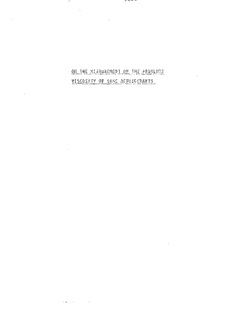Table Of ContentON THE r'IEASURH'lENT OF THE lU3S0LUTE
VISCOSITY OF SOME REFRIGERANTS
_-------
----------~~- .. ......-------~,------_.-
ON THE MEASUREMENT OF THE
ABSOLUTE VISCOSITY OF
SOME REFRIGERANIS
By
SURESH CHANDRA ASRANI
B.E~
A Thesis
Submitted to the Faculty of Graduate
Studies in ~art;al Fulf11ment of the
Requirements for the Degree
Master of Engineering
McMaster University,
Hamilton, Ontario.
MASTER OF ENGINEERING (1969) McMASTER UNIVERSITY
(Mechanical Engineering) Hamilton,Onti'.ir;o.
TITLE: ON THE MEASUREMENT OF THE ABSOLUTE VISCOSITY OF
SOME REFRIGERANTS.
AUTHOR: SURESH CHANDRA ASRANI
B.E. ( Birla Institute of Technology & Science)
SUPERVISOR: Dr. B. Latta
NU~IBER OF PAGES: xi 125
t
SCOPE AND CONTENTS:
Using a series capillary viscometer, absolute viscosity
of two halogenated hydrocarbon referigerants, R-13 and R-500
in vapour phase, has been measured at atmospheric pressure
and in the temperature range ~53.25 to 87.l9DC and -28.64 to
87.38°C respectively. The estimated max'imum el~rot· is of the
~
order 0 f 1.64%. The cxperi mental res u1t s ha'le heencoinparcd
with the previous data.
Viscosity values have been correlated with polynomials
of degree 1 to 5 and an approximate form of Sutherland equation
n = AlIT + B ·
1
Intermolecular force constants have been computed for
R-13 by the collision theory approach, and using these constants
viscosity coefficients have been reported for a tempernture
range of 200 to 1650o K.
i ;
The author is thankful to Dr. B. Latta for his
guidance. Many thanks are also due to the persons who offered
assistance.
The author wishes to thank DuPont of Canada! National
Bureau of Standards and Therrnophysical data centre for supplying
technical information.
The experimental work was supported by the National
Research Counei l! Grant No. A2937.
; i i
TABLE OF CON1ENTS
List of figllt'e.s v
. List of tables
viii
Nomenclature
1 Introduction 1
2 literature Survey 3
3 TheOI'Y 11
4 Design Considerations 16
5 Desct'i pt ion I)f the ApPi.lr &t IIS 20
6 Procedure 42
7 Result and Discussion 44
8 Conclusion 73
9 Appendices
9.1
9.2 Correlating ~he Results Using Collision 81
Theot'y 81
9.3 Calibration of Capillary Tubes 87
9.4 Thermocouple Calibration
103'
9.5 Calibration of ~1owmeter 108
9.6 Pressure Measurement with the Pressure
Tl'an~ducer 109
9.7 Error Estimation 112
9.8 Specimen Calculation 120
10 Reference~ 123
1\1
LIST O_F_FIGURES
.. .._---
-----"'~ ~-,--~---
Title
Reynold number, Mass flow rate, &
Development length Vs Temperature for
R-13 18
2 1\ II Ill! for R-500 19
3 Viscometer assembly 21-
4 Intermediate chamb~r block and
Entrance/Exit chamber 22
5 Clamp 25
6 Stand & Locking device 27
7 He~t exc~ang9 glass tube and the
Ins'J1at'ion box. 29
8 Heat exchange glass tube Cover plate 30.
9 Methanol heat exchanger J4
10 Soap film flowmeter 37
11 Flow diagram 39
12 Viscosity of R-13 Vs TemperctLJn~ '<lhen
fitted to 2nd degree polynomial 47
13 O'eviation of F.!xnerimenta1 results frolll
the fitted 2nd degn~e polynomia1 48
14 2nd degree polyncmial, Visc()sity Vs
Temperature; Combined results 50
15 Viscosity of R-13 Vs Temperature in
{OK , when fi ttEd to 11 <': {l'ln .j- B1 51
v
16 Deviation of experimental results for
R-13 froIl1 the f; t ted equa t ion f " '" A1If+B1 52
17 Fitted equation A,IT + 8 , Viscos'jty
1')= 1
Vs Temperature, Combined results 54
18 Viscosity of R-500 Vs Temperature when
fitted to 4th degree polynomial 56
19 Deviation of experimental results for
R-500 from the fitted polynomial 57
20 Comparision of experimental results for
R-500 with the estimated viscosity
reported in DuPont publication RT-41 59
21 Viscosity of R-500 Vs Temperature
; n R vihen fi t ted to r1 = A1If + B1 60
22 Deviation of experimental results from
the equation '1 ::A11'f ... B'I 61
23 Viscosity of R-13 Vs Temperature,
compared with collision theory 65
24 Deviation of experimental results
for R-13 from the collision theory 66
25 Coapars1on of viscosity values for
R-13 with the collision theory and
2nd degree polynomial 67
26 Viscosity of R-500 Vs Temperature,
compared with collision theory 68
vi
" '
27 Deviation of experimental results
for R-500 from the collision theory 69
28 Comparis1on of viscosity values of
R-500 with the collision theory and
4th degree polynomial 70
29 Capillary tube calibration 97
Capillary tUbe calibration 98
30
Capillary tube calibration 99
31
Capillary tube calibration 100
32
·Capi1lary tube calibration 101
33
Capillary tube calibration 102
34
35 Thermocouple calibration heat
exchangei" 106
36 Therill(IC(1UP1e cal i bI'ati 0n 107
37 Transducer> vfJlve III
Table No. -T_i.t_le-
1 Viscosity of ni h'ogen gas 45
2 Vi scos 'j ty of R-13 46
3 Viscosity of H-500 55
4 Viscosity of R-13 calculated
t
using collision theory 71
5 Small capillary tube calibration 94
6 large capillary tube calibration 95
7 Thermocouple calibration "105
viii
NO!'lIEHCLJ\TURE
_O_E_>_5.0'i 'L).t__l.o•..n._
Constilnts
Constunt
c
Constant
C Centigrade temperature scale
D Constant
E Intermolecular potential field
F Fahrenheit temperature scale
K Kelvin temper~ture scale
L length
Q Volumetric flow rate
Q Hass flow rate
R Reynold number
R Refrigerant
T Absolute temperature in OK
1\ = ~l
T Reduced temperature
f.::
v Volume
Hirschfelder~BirdiSpotz integral
Development len~lt!l
a Radius of capillary tube
Boiling properties
b
ix
Description:McMASTER UNIVERSITY loki connections were exclusively used and teflon
tape was used for . cathetometer stand was levelled by means of three screws.

